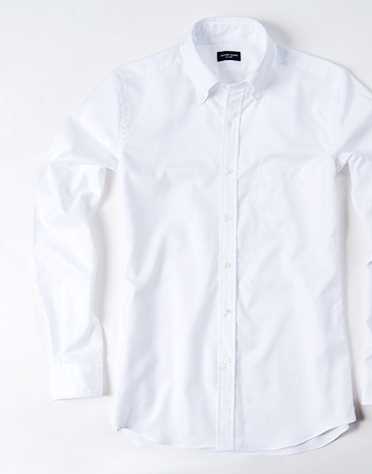




When it comes to washing shirts, many people wonder whether they should button them up before tossing them in the washing machine. Some argue that leaving the buttons undone allows for a more thorough clean, while others insist that buttoning the shirts ensures they maintain their shape. So, should you button shirts before washing them?
Experts weigh in on the matter, and their advice may surprise you. According to laundry professionals, it is recommended to button shirts before washing them. This helps prevent the buttons from getting tangled or snagged during the wash cycle, which can cause damage to the buttons or the fabric. Buttoning up the shirts also helps maintain their shape, as the buttons help support the collar and other areas that can be prone to stretching.
But what about those who argue that leaving shirts unbuttoned leads to a more thorough clean? The experts say that this is a common misconception. While it may seem like leaving the buttons undone would allow the detergent and water to penetrate the fabric better, studies have shown that buttoned shirts still get just as clean. Modern washing machines are designed to agitate the clothes and distribute the water and detergent evenly, so there is no need to leave the buttons undone for a better clean.
So, the next time you’re doing laundry and wondering whether to button up your shirts, remember the advice from the experts. Buttoning shirts before washing them not only helps prevent damage to the buttons and fabric, but it also ensures they maintain their shape. It’s a simple step that can make a big difference in the longevity and appearance of your shirts.
Benefits of Buttoning Shirts Before Washing
Buttoning shirts before washing them can provide several benefits. Here are some reasons why you should consider buttoning your shirts before throwing them in the washing machine:
1. Prevents damage to the buttons

When you button your shirts before washing, it helps to protect the buttons from getting tangled or snagged on other clothes or the washing machine’s drum. This can help prevent the buttons from breaking or getting damaged during the wash cycle.
2. Maintains shirt shape and structure
Buttoning shirts before washing them helps to maintain their shape and structure. When the shirts are buttoned, they are less likely to stretch or lose their original form during the washing process. This can be particularly important for formal or tailored shirts.
3. Minimizes wrinkling
Buttoning shirts before washing can help minimize wrinkling. When the shirts are buttoned, the fabric is held in place, reducing the chances of excessive wrinkling. This can save you time and effort during the ironing or steaming process after washing.
4. Preserves shirt quality
Buttoning shirts before washing helps to preserve their overall quality. Proper care, such as buttoning the shirts, can extend their lifespan and keep them looking newer for longer. By avoiding damage to the buttons and reducing the risk of stretching or wrinkling, you can maintain the appearance and integrity of your shirts.
5. Easier sorting and folding
Buttoned shirts are easier to sort and fold after washing. When the shirts are buttoned, they stay neatly in place, making it simpler to organize and fold them. This can save you time and keep your wardrobe more organized.
Overall, buttoning shirts before washing them can help protect the buttons, maintain the shirt’s shape and structure, minimize wrinkling, preserve the shirt’s quality, and make sorting and folding easier. It’s a small step that can contribute to better garment care and longevity.
Preserving the Shape and Fit
Properly buttoning your shirts before washing them can help preserve their shape and fit. Here are a few reasons why this is important:
-
Prevents stretching: Buttoning your shirts before washing keeps the fabric in place and prevents it from stretching out. This is particularly important for shirts made from delicate or stretchy materials.
-
Maintains collar shape: Buttoning the top button and folding the collar down can help maintain the shape of the collar. This is especially important for dress shirts with stiff collars.
-
Keeps buttons intact: When shirts are unbuttoned during washing, the buttons can get caught on other clothes or the washing machine drum, resulting in damage or loss. By buttoning the shirts, you can ensure that the buttons stay intact.
-
Preserves the fit: Buttoning your shirts before washing helps to preserve their original fit. If the shirts are left unbuttoned, they may become misshapen or distorted in the wash, affecting how they fit when you wear them.
By taking the time to button your shirts before washing them, you can help extend their lifespan and maintain their appearance. It’s a small step that can make a big difference in the longevity of your shirts.
Keeping Buttons Intact
Buttons are an important part of a shirt and can easily get damaged during the washing process. Taking proper care of the buttons can help ensure that they stay intact and avoid any unnecessary damage. Here are some tips to keep your buttons in good condition:
1. Button up the shirt
Before putting your shirt in the washing machine, make sure to button it up. This will prevent the buttons from getting snagged or pulled off during the washing cycle.
2. Turn the shirt inside out
Turning the shirt inside out can help protect the buttons from rubbing against other clothes or the washing machine drum. It can also prevent the buttons from getting caught on anything and reduce the risk of them getting damaged.
3. Choose a gentle cycle
Using a gentle washing cycle can help minimize the agitation and reduce the chances of buttons coming loose or getting damaged. Selecting a delicate or hand wash cycle can be a suitable option for shirts with delicate buttons.
4. Avoid high temperatures
High temperatures can cause the buttons to melt or crack, leading to irreparable damage. It is best to wash shirts with buttons in cold or lukewarm water to safeguard them from extreme heat.
5. Use a gentle detergent

Harsh detergents can weaken the threads holding the buttons in place, making them more prone to falling off. Opt for a mild and gentle detergent that will be less abrasive on the buttons.
6. Handwash delicate buttons
If your shirt has delicate buttons or buttons made from materials such as mother-of-pearl or metal, it is advisable to handwash them. This ensures that you have better control over the washing process and can prevent any potential damage to the buttons.
7. Air dry the shirt
Avoid using a dryer to dry your shirts with buttons, as the high heat can cause the buttons to become brittle and break. Instead, gently squeeze out any excess water and hang the shirt to air dry. This will help preserve the integrity of the buttons.
8. Mend loose buttons promptly
If you notice any loose buttons, it is important to mend them promptly. Leaving them unattended can lead to further damage and make it more challenging to repair them in the future.
By following these tips, you can help keep your shirt buttons intact and ensure that your shirts look great wear after wear.
Precautions When Buttoning Shirts for Washing
- Inspect the shirt for any loose or missing buttons before buttoning it up.
- If there are any loose buttons, sew them back on securely before washing the shirt.
- Make sure to unbutton all the buttons on the shirt, including the collar and cuffs.
- If the shirt has delicate buttons, such as ones made of pearl or mother-of-pearl, it’s best to unbutton them before washing.
- Check the care label on the shirt for any specific instructions on buttoning before washing.
- If the care label recommends buttoning the shirt for washing, make sure to follow the instructions provided.
- Buttoning the shirt before washing can help maintain its shape and prevent it from stretching or getting tangled with other clothes.
- When buttoning the shirt, take care not to pull or tug too hard on the buttons, as this can cause them to become loose or break.
- Ensure that all buttons are properly aligned in the buttonholes to avoid any damages during the washing process.
- After buttoning the shirt, place it in a mesh laundry bag or pillowcase to protect it from rubbing against other items in the washing machine.
- Always wash shirts with similar colors to prevent color bleeding or transfer.
- Use a gentle cycle and mild detergent when washing buttoned shirts to minimize the risk of damaging the buttons or fabric.
- Avoid using high heat when drying buttoned shirts, as this can cause shrinkage or damage the buttons. Instead, opt for a low or medium heat setting.
- After washing, unbutton the shirt and smooth out any wrinkles before hanging or laying it flat to dry.
Avoiding Button and Fabric Damage
To ensure that your buttons and fabric stay in good condition, it’s important to take the necessary precautions when washing your shirts.
Here are some expert tips to avoid button and fabric damage:
- Unbutton the shirt: Always unbutton the shirt before washing it. This helps prevent stress on the buttons and reduces the risk of them coming loose or getting damaged during the wash.
- Sort by color and fabric: Sort your shirts by color and fabric type before washing. This prevents color bleeding and minimizes the risk of fabric damage. Read the care labels on your shirts to ensure you wash them on the appropriate settings.
- Use a gentle cycle: Opt for a gentle cycle or hand wash setting on your washing machine to minimize agitation. This helps prevent buttons and fabric from getting snagged or pulled.
- Avoid high heat: High heat can damage buttons and shrink certain fabrics. Use a lower heat setting or air-dry your shirts to keep them in good condition.
- Button the shirt after washing: Once the shirt is clean and dry, button it up to maintain its shape. This also helps prevent buttons from getting lost or misplaced.
By following these tips, you can keep your shirts looking great and avoid unnecessary button and fabric damage during the washing process.
Preventing Snagging and Tangling
When washing shirts, it is important to take steps to prevent snagging or tangling, as these can damage the fabric or result in a misshapen garment. Here are some expert tips to help you avoid these issues:
1. Button up your shirts
Before putting your shirts in the washing machine, it is best to button them up. This will prevent the buttons from getting caught on other items or the washing machine’s agitator, reducing the risk of snagging.
2. Turn shirts inside out
Another useful tip is to turn your shirts inside out before washing them. By doing this, the buttons and other embellishments are protected, and the delicate outside surfaces are less likely to come into direct contact with other items or the washing machine’s agitator.
3. Separate delicate fabrics

If you have delicate fabrics, like silk or lace, it is advisable to wash them separately from other garments. Delicate fabrics are more prone to snagging and tangling, so washing them alone reduces the risk of damage.
4. Use a laundry bag
For particularly delicate or embellished shirts, using a mesh laundry bag can provide an extra layer of protection. Simply place the shirt inside the bag before placing it in the washing machine. The bag will prevent direct contact with other items and reduce the risk of snagging.
5. Opt for a gentle cycle
When washing shirts, choose a gentle cycle on your washing machine. This setting is designed to minimize agitation, which can cause tangling or snagging. It is also recommended to use a mild detergent to further protect the fabric.
6. Air dry shirts
Avoid using a clothes dryer to dry your shirts, as the tumbling motion can exacerbate tangling and increase the risk of snagging. Instead, opt to air dry your shirts by laying them flat or hanging them on a clothesline. This will help the fabric retain its shape and reduce the likelihood of damage.
By following these expert tips, you can prevent snagging and tangling when washing your shirts, ensuring that they stay in great condition and last longer.
Expert Tips for Buttoning Shirts Before Washing
1. Preserve the Shape and Appearance
Buttoning your shirts before washing them can help preserve their shape and appearance. When shirts are left unbuttoned, the fabric can stretch or deform during the washing process, leading to wrinkles or an uneven fit. By buttoning the shirts, you ensure that they retain their intended shape and drape properly on your body.
2. Protect the Buttons
Buttoning shirts before washing can also help protect the buttons. Loose buttons can easily get caught on other clothes or the washing machine drum, leading to damage or loss. By securing the buttons, you reduce the risk of them getting snagged or broken during the wash cycle, ensuring your shirt stays intact and functional.
3. Facilitate Thorough Cleaning
Buttoning your shirts allows for a more thorough cleaning. Closed buttons prevent the washing machine from pushing the fabric apart, ensuring that dirt, stains, and odours are properly washed out. This helps to keep your shirts cleaner and fresher, as all areas of the fabric are subjected to the washing process.
4. Simplify Ironing and Folding
Buttoning shirts before washing can simplify the ironing and folding process. When shirts are properly buttoned, they maintain their shape, and the collar, cuffs, and front placket stay in place. This makes it easier to achieve a crisp, wrinkle-free finish when ironing, and ensures neater folding after the shirts are dried.
5. Prevent Shrinkage

Buttoning your shirts before washing can help prevent shrinkage. When shirts are left unbuttoned, the fabric is more likely to warp and shrink in the wash. By buttoning the shirts, you help maintain the original dimensions and reduce the risk of them becoming too small or tight.
6. Avoid Tangling
Buttoning shirts can prevent tangling with other clothes during the washing cycle. When shirts are left unbuttoned, their loose parts can wrap around other garments, resulting in a tangled mess. By buttoning the shirts, you minimize the chance of them getting intertwined with other items, making the washing process more efficient and preventing damage to the fabric.
7. Recommended Buttoning Techniques
When buttoning shirts before washing, it is recommended to:
- Button all the buttons on the front placket, including the top and bottom buttons.
- Button the cuffs, if applicable.
- Button any other decorative or functional buttons on the collar or pockets.
8. Check Clothing Labels
Always check the clothing labels for specific washing instructions. While buttoning shirts before washing is generally beneficial, there may be exceptions for certain fabrics or styles. The clothing labels will provide guidance on the best practices for washing your shirts.
By following these expert tips and buttoning your shirts before washing, you can ensure that your shirts are cleaned effectively, protected from damage, and maintain their optimal appearance and fit.
FAQ
Is it necessary to button shirts before washing them?
Yes, it is recommended to button shirts before washing them. Buttoning the shirts helps to maintain their shape during the washing process.
What happens if you don’t button shirts before washing them?
If you don’t button shirts before washing them, they can become stretched or warped in the washing machine. This can affect the fit and appearance of the shirt.
Does buttoning shirts prevent damage during washing?
Yes, buttoning shirts before washing them can help prevent damage. By buttoning the shirts, you minimize the risk of buttons getting caught on other items or the washing machine’s agitator.
Can shirts get tangled in the washing machine if not buttoned?
Yes, shirts can get tangled in the washing machine if they are not buttoned. This can lead to wrinkles and creases that may be difficult to remove.
Should I unbutton shirts before hanging them to dry?
It is generally recommended to unbutton shirts before hanging them to dry. This allows the fabric to dry evenly and helps prevent buttons from becoming misshapen.
Should I button my shirts before washing them?
Yes, it is generally recommended to button your shirts before washing them. This helps to maintain the shape of the shirt and prevents unnecessary stress on the buttons and buttonholes during the washing process.
What happens if I don’t button my shirts before washing them?
If you don’t button your shirts before washing them, they may become stretched and lose their shape. The buttons and buttonholes may also be subjected to more stress, increasing the likelihood of them becoming damaged or falling off.












